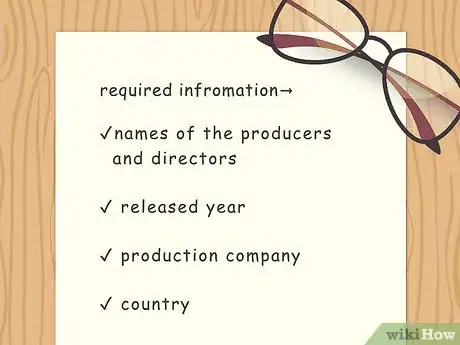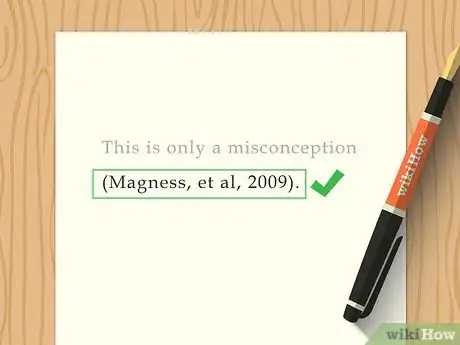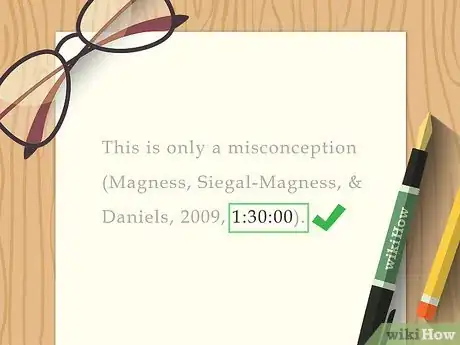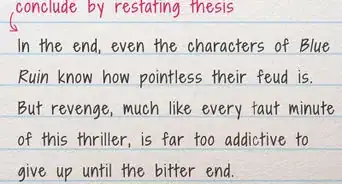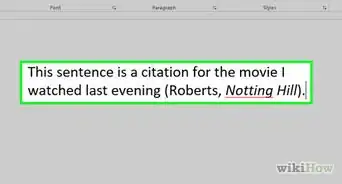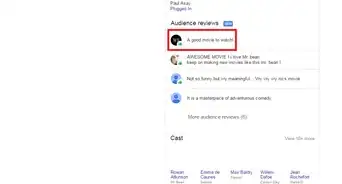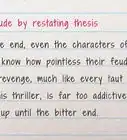This article was co-authored by Cara Barker, MA and by wikiHow staff writer, Jennifer Mueller, JD. Cara Barker is an Assistant Professor and Research and Instruction Librarian at Hunter Library at Western Carolina University. She received her Masters in Library and Information Sciences from the University of Washington in 2014. She has over 16 years of experience working with libraries across the United States.
This article has been viewed 107,657 times.
When writing a research paper, you may find that you want to use a feature film as a reference. You may be citing the movie as a whole as an example of a certain way of thinking or type of behavior. You also might want to cite or quote a specific thing said in the movie. When citing a movie using the American Psychological Association (APA) citation method, you follow the same basic format as you would for a book, using the producer and director of the film as the authors.[1]
Steps
Sample Citations
Citing a Movie
-
1Gather information for your citation. As with any APA citation, you will need basic information about the movie you want to cite. Much of this information will be available in the credits of the movie itself.[2]
- You will need the names of the producers and directors, the year the movie was released, the production company, the studio that released the movie, and the country where the movie was produced.
- Keep in mind that the studio may change if the film rights are purchased by another company. However, either the original or new studio name would be acceptable to include in the citation.
- To get this information, you can take notes during the credits of the film, or look the film up on the Internet Movie Database (IMDb).
-
2Provide the last name and first initial of producers and directors. You typically start any APA citation with the last name of the author, since your reference list will be alphabetized by author. For a movie, the producer and director are considered the authors.[3]
- Put the person's role in parentheses after their name. List producers first, then the director. If there are multiple names, separate them with commas, using an ampersand before the last name. For example: "Magness, G., Siegel-Magness, S. (Producers), & Daniels, L. (Director)."
- If one person is both producer and director, include both roles in parentheses after their name. For example: "Hitchcock, A. (Producer/Director)."
Advertisement -
3Include the year of production in parentheses. The copyright year, or year the movie was produced, is the next piece of information in your citation. If you watched the movie on DVD, the DVD itself may have a different year of production, but you want the original year for your citation.[4]
- For example: "Hitchcock, A. (Producer/Director). (1941).
-
4Add the title and format of the movie. The title of the movie should be in italics, using sentence-style capitalization. Typically only the first word of the title and any proper names will be capitalized. Include the format in which you viewed the movie in brackets after the title.[5]
- Use the format "Motion Picture" if you watched the movie in the theater. For example: "Hitchcock, A. (Producer/Director). (1941). Suspicion [Motion Picture]."
- If you watched the movie on DVD or some other format, include the name of that format instead. For example: "Magness, G., Siegel-Magness, S. (Producers), & Daniels, L. (Director). (2009). Precious [DVD]."
-
5List the country and production company. The movie may have been filmed in several different countries, but you want the country of origin – usually the original country where the movie was released. Put a colon after the country, and then list the name of the movie studio that released the movie.[6]
- For example: "Hitchcock, A. (Producer/Director). (1941). Suspicion [Motion Picture]. United States: Turner."
- Alternatively, your citation make look like: "Magness, G., Siegel-Magness, S. (Producers), & Daniels, L. (Director). (2009). Precious [DVD]. United States: Lionsgate."
- If you watched the movie online, type the words "Retrieved from" and provide a direct URL where the movie can be accessed.[7]
Writing an In-Text Citation
-
1Provide the last name of producers and directors with the year of production. When you mention a movie in text, you typically want to follow that mention with a parenthetical citation. Use the standard APA author-date format, except that for movies the producers and directors are considered the authors.[8]
- For example: "(Magness, Siegal-Magness, & Daniels, 2009)."
- Do not include the words producer or director after the names in parenthetical in-text citations.
-
2Use the "et al" abbreviation in subsequent in-text citations. After the first in-text citation, you need only list the first name followed by the Latin abbreviation "et al" and the year of production. An exception is if there are only 2 producers or directors; in this case, list them each time. Also, if the movie has more than 6 producers and directors, only list the first one followed by "et al" for every citation.[9]
- For example: "(Magness, et al, 2009)."
-
3Use a time-stamp to locate specific information. If you want to direct your reader to a specific scene or part of the movie, follow the year of production with a time stamp or range of time stamps.[10]
- For example: "(Magness, Siegal-Magness, & Daniels, 2009, 1:30:00)."
- Reflect the format shown in the movie itself, putting zeroes in places where necessary. For example, if a movie's time is reflected in hours, minutes, and seconds, and you're citing something that occurred at the 30-minute mark, you would need a zero for the hours: 0:30:00.
- You'll have to pause the movie to identify the time when the part you're citing occurs. If you watched the film in a theater, you won't be able to do this, so take notes as best you can. By writing down the time, you can calculate the time stamp with reference to the time the movie started.
-
4Omit the in-text citation where unnecessary. You already have a full citation for the movie in your references. If you include enough information in the text that your reader can correctly identify the movie's full citation in your reference list, there's no need for a parenthetical in-text citation.
- Since your citations start with the producer's and director's names, this generally means you need a parenthetical citation unless you've mentioned the name in your text.
- For example, the sentence "Hitchcock's film Suspicion is unusually light-hearted but still suspenseful" would not need a parenthetical citation. You have already mentioned the producer and director's name (Hitchcock) along with the name of the film, so your readers will easily be able to find it in your reference list.
Community Q&A
-
QuestionDo I need to put writer's name in the in-text citation? If yes, could you give me an example?
 Community AnswerYou do not need to add the writer's name when you are citing an actual movie. If, for some reason, you are citing the screenplay alone, follow the formatting above, but do not add the producer or director (unless they also wrote), do not specify "(writer)" in the bibliography--this is already understood, as if it were a book--and refer to page numbers rather than timestamps.
Community AnswerYou do not need to add the writer's name when you are citing an actual movie. If, for some reason, you are citing the screenplay alone, follow the formatting above, but do not add the producer or director (unless they also wrote), do not specify "(writer)" in the bibliography--this is already understood, as if it were a book--and refer to page numbers rather than timestamps. -
QuestionAre the assistant producers to be included as well?
 TorpiTop AnswererNo, nor the people credited as "executive producer", or any other kind of producer other than just "producer". Just the producers and directors (but similarly, not assistant directors or second unit directors).
TorpiTop AnswererNo, nor the people credited as "executive producer", or any other kind of producer other than just "producer". Just the producers and directors (but similarly, not assistant directors or second unit directors).
References
- ↑ http://libguides.gwumc.edu/c.php?g=27779&p=170347
- ↑ http://libguides.css.edu/c.php?g=41681&p=265021
- ↑ http://libguides.gwumc.edu/c.php?g=27779&p=170347
- ↑ http://libguides.gwumc.edu/c.php?g=27779&p=170347
- ↑ http://libguides.css.edu/c.php?g=41681&p=265021
- ↑ http://libguides.gwumc.edu/c.php?g=27779&p=170347
- ↑ http://blog.apastyle.org/apastyle/2014/01/timestamps-for-audiovisual-materials-in-apa-style.html
- ↑ http://libguides.gwumc.edu/c.php?g=27779&p=170347
- ↑ https://valenciacollege.edu/library/mla-apa-chicago-guides/documents/VideoAPA6.pdf
About This Article
To do an in-text citation of a movie in APA, include a parenthetical citation after you mention the movie in the text, unless you mentioned the name of the movie and the director's name, in which case you don't need a citation. To make your parenthetical citation, include the last names of the movie's producers and directors, followed by the year the movie came out. In subsequent citations, you can just list the first name followed by "et al" instead of writing out each name. To learn how to cite a movie in APA in a reference list, read on!


